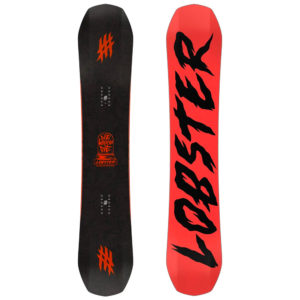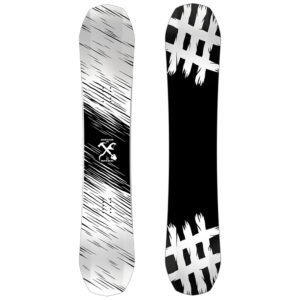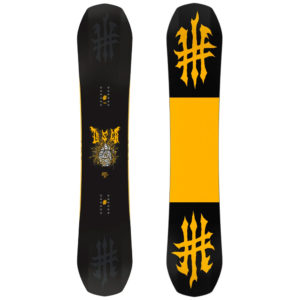Lobster Halldor Pro 2020 Review
The Lobster Halldor Pro is the mid flexing twin board, made to ride the big stuff that Halldor rides.
Features of the Lobster Halldor Pro
Core DST
Two hollow carbon rods are made into the core to give the board extra pop.
Light Core
A mix of poplar and paulownia wood, that gets a balance between strength and weight.
Tri-Ax Laminate
Three directions of glass give the board a bit more torsional strength.
Ultra Glide S Base
A hard and fast sintered material, that soaks up wax well and rides quickly.
Flip Flop Base
The offcuts of the base material aren’t wasted, so while one board might have a yellow middle section with black nose and tail, the next board will have a black middle section with yellow nose and tail.
Carbon Strips
There are 6 carbon strips that run from edge to edge (3 under each binding) to give the board extra support and a direct feel when swapping edges.
5/10 Flex
A medium flex rating
Twin 3BT
With a fairly wide centerbase, the board still has a stable feel when riding fast, with a smaller uplift the gets a bit more obvious out towards the widest parts of the board.
Sidekick
The Sidekick is a small section of the 3BT (the sections with the lines close together on the graphic) and is raised up even more, to help starting turns as well as helping in powder.
Sizes available:
- 151cm
- 154cm
- 156cm Wide
- 157cm
- 159cm
- 159cm Wide
How the halldor pro Rides
Board size: 157cm
Boots: Salomon Launch 27.5/US 9.5
Bindings: Flux RII
This review is based on me riding the 2020 157cm Halldor Pro, which was set up with my bindings set up to my regular +12 degrees on my front foot, with -9 on the back.
The snow was a combination of hardpacked groomers, with around about 15cm of fresh powder in the trees.
Camber Profile
The Halldor Pro has quite a lot of camber in it. The Lobster brochure and website are very vague on details of their boards, but it is quite a lot. With the Twin 3BT shaping, as far as Bataleons/Lobsters go, it doesn’t have a huge amount of side base lift, so that it isn’t a loose as most of the other options.
The higher amount of camber, meant that it had a solid and stable overall feel, except for the 3BT part of it. Riding with a flat base takes some getting used to, though once you are on your edge you get back to the feel of a regular camber board.
Flex and Pop
Although it is rated as having a 5/10 flex, it felt quite a bit stiffer to me. So far Lobsters flex ratings seem all over the place. The Lobster Aaron Schwartz board is rated as a 4/10, to me it felt like it was barely a 2/10. The Halldor is rated as a 5/10, to me maybe an 8/10. Either way, I wouldn’t put much faith in the numbers from any brand. Possibly the boards break in a ton, and soften right up after a few weeks of riding?
I was riding the 157cm and weigh around 72kg, so I should be somewhere in the middle of the weight range. Presses took work, I had to make sure to get all my weight over the nose or tail of the board, and I could feel it fighting it the whole way. Ollies were no problem at all, you can load up the tail and it pushes back hard, making big ollies seem easy.
Landing in powder was really nice, the tail had plenty of stiffness if you land in the backseat, and in powder it had a good surfy feel when you were leaning right back.
Edge Hold
Once you get the board over onto its edge, past the 3BT point it starts to grip well. Up until that point, it is loose, skatey and easy to move around without any chance of catching an edge. When you are in the middle of a turn, it holds well even on icy windblown snow, but until you get it on the edge, it doesn’t have much control.
Float
The float of the Halldor was ok, but that was probably due more to the length, rather than anything else seeing that it is a twin, and it was set up with a centered stance.
Speed
It has a sintered base, though the board I rode was definitely in need of a wax, so it didn’t feel quick on cat tracks or groomed runs that weren’t steep.
Pros:
- Tons of pop
- Quite stable
Cons
- No real stand out features of the board
Overall
The Halldor Pro would be one of the better options out of the Lobster range if you ride fast, hit the big jumps and need something stable. The solid medium-stiff flex is going to handle almost all types of riding, and it gives you tons of pop. As far as the 3BT goes, it is one of the less loose options, but if you aren’t used to that feel just be prepared for a couple of days of getting used to it. Once you adjust your riding to take advantage of the 3BT, you can get a decent mix of a loose board you can be messy with, and a grippy board with a regular camber feel that still carves and holds a good edge.
Being a pretty specific board in a more niche brand, if you are looking at this you probably know all about Halldor, and I can easily see how this is the board you would want to ride the full on stuff like he does.
Lobster Halldor Pro 2020 Technical Specs
| Length | Effective Edge (mm) | Setback (mm) | Waist Width (mm) | Sidecut (m) |
| 151 | 1153 | 0 | 246 | 7.8 |
| 154 | 1175 | 0 | 250 | 7.9 |
| 157 | 1197 | 0 | 253 | 8.1 |
| 159 | 1217 | 0 | 256 | 8.2 |
| 156 Wide | 1192 | 0 | 264 | 7.9 |
| 159 Wide | 1217 | 0 | 266 | 8.2 |

2019

2018

Find the best price on the Lobster Halldor Pro